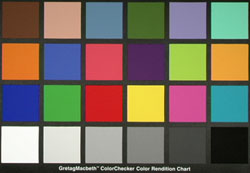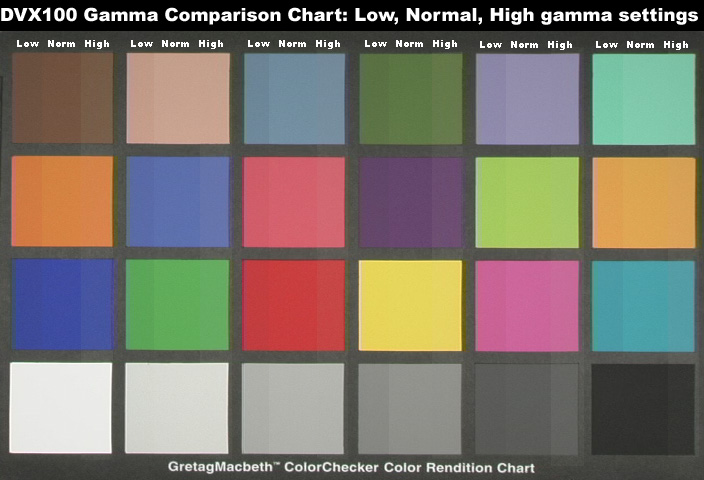In the image below I compare the "normal" gamma setting
with the "cine-like" setting, again using the same exposure for each. You
can see that the white level is nearly the same, but the midtones are all
darker in the "cine-like" image, except for the darkest level (lower right
box) where the cine-like image is lighter. Note that there is a hint of yellow
in the cine version of the white box (lower left). I believe my white-balance
paper was slightly more blue than the Macbeth white reference,
and the DVX with cine gamma is not saturating at
this level so it presents a truer color. The normal gamma curve compresses
peak R,G,B levels and pushes all very bright colors towards neutral white.
It appears that the cine-like setting preserves more image information, if your
scene does not have hard-clipped white levels.
In the matrix settings, the "fluorescent" setting appears to mostly affect
the red and yellow colors making them more saturated relative to the normal
setting. The "cine-like" matrix makes all the colors more saturated.
Note that the neutral gray tones remain unchanged by different matrix settings.
Exposure was the same as in the above gamma test.
For this matrix comparison I used
"normal" gamma.

Camera settings for all tests: Gamma (as indicated), Matrix
(as indicated), Detail -4, Chroma Level 0, Chroma Phase 0, Color 0, Master
Ped -5, Iris -3, Skin Tone Dtl Off, Detail Thin, 24P normal.
Manual exposure 1/48 sec, f/8.0, 0 dB, no N/D filter. Manual white balance
on white paper. Lighting: two 60 W halogen floods (one on each side) at 18".
I manually set exposure (f/8) to just barely not clip on the white square.
A spotmeter on a grey card (set for ASA 400) also indicated f/8. I locked off
the exposure at f/8 and used this setting for all the gamma and matrix shots.
Back
to main page.




